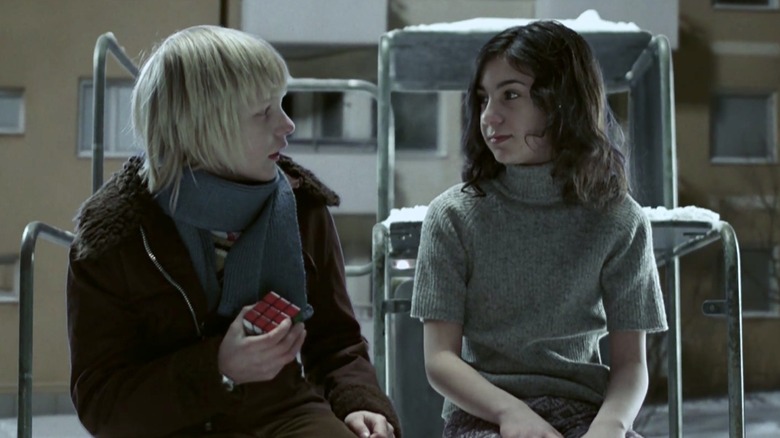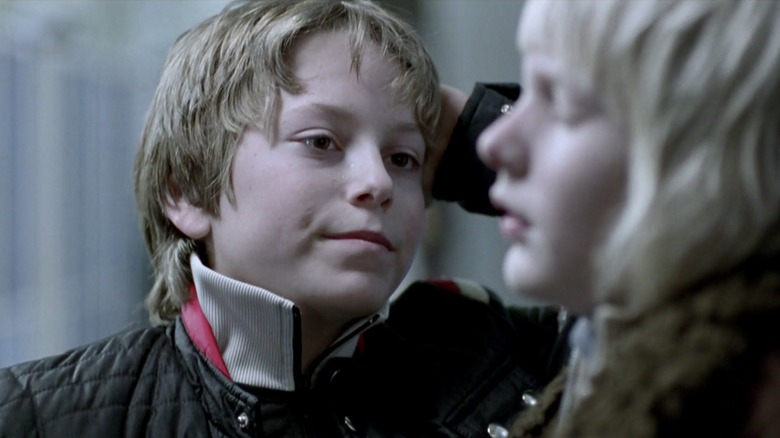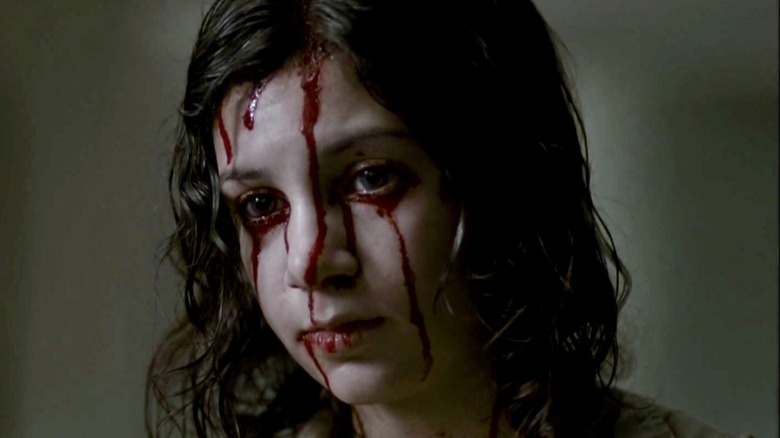Director Tomas Alfredson Broke His Own Rules To Make Let The Right One In
Bibliophiles and even sometimes cinephiles will espouse the sentiment that "the book is better than the movie." But like the undead creatures at the heart of it, the vampire film genre has shown a remarkable ability to adapt and re-adapt certain seminal texts such as Bram Stoker's "Dracula," Anne Rice's "Interview with the Vampire," and John Ajvide Lindqvist's "Let the Right One In." The latter book, a Swedish vampire novel published in 2004, even managed to spin out two great film adaptations within two years of each other. The first one came out of the author's own native country. Lindqvist himself wrote the screenplay for it, and it utilized the same title as the book: "Låt den rätte komma in," Swedish for "Let the Right One In."
"Let the Right One In" was a breakthrough film for director Tomas Alfredson, who followed it up three years later with a movie based on the John le Carré novel, "Tinker Tailor Soldier Spy." Yet despite his obvious pedigree in adapting books for the big screen, Alfredson was not always on board with that in principle. In 2008, before "Let the Right One in" went into limited release in the U.S., Alfredson told The Los Angeles Times:
"I really think you shouldn't do films of good books. The reason is that the depth of a good book is so much greater than you could possibly do on screen in 90 minutes. But this was sort of the exception."
At the time, Alfredson had more of a background in theater and comedy in Sweden. He had mounted a production of the musical "My Fair Lady" and was not an avowed horror fan. However, in Lindqvist's novel, he saw something that he could work with as a filmmaker.
'This vampire is all the violent feelings'
Lindqvist's book resonated with Alfredson on a thematic level and he seemed to augur the most meaning out of its depiction of the psychological effects of bullying. The first line of dialogue spoken in "Let the Right One In" is, "Squeal like a pig," and we soon learn the meaning of this as we see our youthful protagonist, Oskar (Kåre Hedebrant) being bullied at school. Another boy, Conny (Patrik Rydmark) corners him, flicks his nose, and tells him, "What a good little piggy you are." Alfredson said of the book:
"It's very hard and very down-to-earth, unsentimental. I had some period when I grew up when I had hard times in school. So it really shook me. Also, when bullied children are portrayed, it is always so sentimental. I don't think it's so sentimental for children being bullied. On the contrary, they store up a lot of very violent feelings. I think that this vampire is all the violent feelings he gets from his tormentors."
Interestingly, Alfredson offered the suggestion that Eli (Lina Leandersson), the vampire with glow-in-the-dark eyes who befriends Oskar, might be a figment of his imagination. "Maybe Eli is just a fantasy," he said. This is just one possible reading of the film, but it opens up the interpretation that Eli is an imaginary friend, born of Oskar's desire to lash out and retaliate against Conny and company.
Note that when Eli first rolls up on Oskar's apartment building, Oskar is looking through his own naked reflection in the window. It's as if Eli, the 12-year-old "girl" with a husky voice and androgynous features, is arriving into Oskar's very consciousness. When they first meet, Oskar is knifing a tree, fantasizing about fighting back, while Eli stands over his shoulder.
'Be me for a little while'
Filmmaker Matt Reeves, who has since gone on to direct "The Batman," would re-adapt Lindqvist's novel as "Let Me In," two years after "Let the Right One In" became an international crossover hit. Reeves changed the setting and gave the story distinctly American shadings, using different background flourishes, like Ronald Reagan's "Evil Empire" speech, to drive home a similar idea of the vampire as one's dark side, projected outward, waiting to be invited in.
Film is a visual medium that is usually less focused on internal monologues and more focused on external reality, the visible displays of emotion on actor's faces. Unless it uses voiceover narration to put us in their headspace, it can't always depict the inner lives of characters in a manner that is as clear, rich, or deep as prose. The figure of Eli, however, presented Anderson with the opportunity to have one character act as another's shadow self. Maybe this is why Anderson felt free to make "Let the Right One In" his first exception to the rule of literary adaptations.
In "Let the Right One In," Eli tells Oskar, "Bravo," after he shares the news that he sent Conny to the ER. At the lake, Oskar himself gets off on hurting Conny; you can see it in his face. Later, he says, "I don't kill people," and Eli retorts, "But you'd like to ... if you could. To get revenge."
Even if the viewer accepts Eli at face value as a character separate from Oskar, it's clear that Eli still functions at certain moments as the personification of Oskar's pent-up emotions, his internal monologue writ external. Eli is the supernatural neighbor who empowers Oskar to solve Rubik's cubes and stand up for himself. Like the empathy machine of movies and the outside perspectives they themselves show, all it takes is a willingness on his part and the viewer's to surrender to the words, "Be me for a little while."


